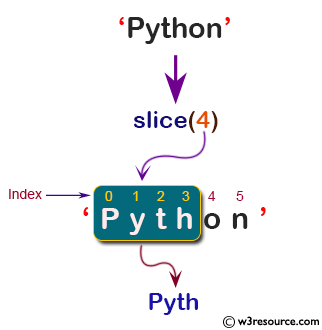Python: slice() function
slice() function
The slice() function is used to get a slice object representing the set of indices specified by range(start, stop, step).
Version:
(Python 3.2.5)
Syntax:
slice(stop) slice(start, stop[, step])
Parameter:
| Name | Description | Required / Optional |
|---|---|---|
| start | An integer number specify where to start the slicing. Default is 0. |
Optional. |
| stop | An integer number specify where the slice will end. |
Required. |
| step | An integer number specify the step of the slicing. Default is . |
Optional. |
Return value:
A slice object.
Example: Python slice()
pyStr = 'Python'
# contains indices (0, 1, 2, 3)
# i.e. P, y , t and h
sliceObj = slice(4)
print(pyStr[sliceObj])
# contains indices (1, 5)
# i.e. y and h
sliceObj = slice(1,5, 2)
print(pyStr[sliceObj])
Output:
Pyth yh
Pictorial Presentation:

Example: Python slice() with negative index
pyStr = 'Python'
# contains indices (-2, -3, -4)
# i.e. o, h and t
sliceObj = slice(-1, -3, -1)
print(pyStr[sliceObj])
Output:
no
Python Code Editor:
Previous: setattr()
Next: sorted()
Test your Python skills with w3resource's quiz
